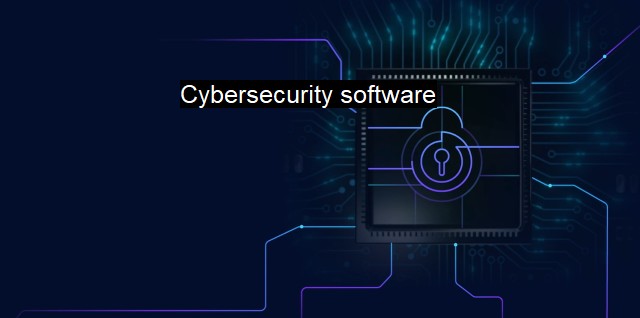What is Cybersecurity software?
Why Cybersecurity Software is Crucial in Today’s Digital Age: Protecting Your Data and Infrastructure Against Rising Threats
Cybersecurity software refers to the extensive suite of technological tools used to ensure the protection of internet-connected systems, devices, networks, and data from cyber threats. This kind of software provides an essential shield against various forms of cyberattacks, including malware, phishing, ransomware, Distributed Denial of Service (DDoS), and other threats.In the rapidly expanding realm of the internet, the frequency and sophistication of cyber attacks have increased exponentially. This necessitates reliable cybersecurity software to mitigate the risks associated with these online threats to safeguard everything from individual private information to national security.
One of the pivotal elements of cybersecurity software is antivirus software. It is a program designed to prevent, search for, detect, and remove software viruses, and other malicious software like worms, trojans, adware, and more. It is the original form of protection that continues to play a critical role in the cybersecurity landscape.
Antiviruses function on two major detection methods - executable-based and behavior-based detection. Executable-based detection entails risk assessment through the analysis of malicious behavior patterns in a database. In contrast, behavior-based detection notes the behavior of executable files and applications to identify suspicious activity.
Modern cyber protection extends well beyond traditional antivirus software and involves robust tools and processes. It includes enhanced firewalls, intrusion detection systems (IDS), intrusion prevention systems (IPS), and more. Several software utilities even encompass complete cybersecurity packages that could provide web filtering, anti-spam, application control services in addition to the basic antivirus functionality.
Firewalls regulate network traffic using predetermined security rules to block or allow traffic, thus establishing a barrier between a trusted and an untrusted network. IDS identifies possible incidents, logs information about them, and reports attempts, while IPS aids in preventing the identified incident.
Cybersecurity software operates based on the principle of defense in depth, where it layers different tools and defenses on top of one another to protect the user's system or network. This layered approach entails a combination of technical, procedural, and administrative actions.
Over the years, the demand for more sophisticated cybersecurity software has escalated due to the increasing wealth of personal and sensitive data held in digital formats. Commercial enterprises, government agencies, financial institutions, and healthcare sectors are increasingly targeted by cybercriminals. Consequently, these sectors have been leading in employing comprehensive cybersecurity software solutions for their digital infrastructure. Advanced cyber-security software nowadays uses Artificial Intelligence (AI) and Machine Learning (ML) algorithms to proactively identify and counteract new, sophisticated threats in real-time.
All cybersecurity solutions include regular updates (or 'patches') to their software to stay ahead of the latest cyber threats. Without these updates, systems and networks are left exposed to threats that continually evolve to bypass outdated defenses.
While it is undeniable that cybersecurity software is of paramount importance, it is equally essential to remember that it forms just one part of the entire framework of cybersecurity. The human element is equally potent - users must exhibit safe online behavior and proper digital hygiene to optimize cybersecurity efforts comprehensively. Education on recognising phishing, possibilities of social engineering attacks and maintaining complex, unique passwords are integral to pairing with excellent cybersecurity software.
Cybersecurity software constitutes a vital line of defense in the digital world-saving online activities from known and unknown cyberthreats. By utilising sophisticated methods and tools, it identifies, reports, and neutralizes potential threats to keep digital data secure. Considering the accelerating digitalization pace and the increasing cyber threats, one can only expect the science of cybersecurity software to continue evolving.

Cybersecurity software FAQs
What is cybersecurity software?
Cybersecurity software is a type of software that helps protect computer and network systems from unauthorized access, theft, and damage. It includes antivirus software, firewalls, intrusion detection systems, and other tools that help prevent and detect cyber attacks.What is antivirus software?
Antivirus software is a type of cybersecurity software that is designed to detect, prevent, and remove malicious software, such as viruses, Trojans, and worms. It scans files and programs for known patterns of malicious code and can also use behavioral analysis to identify new and unidentified malware.Why is cybersecurity software important?
Cybersecurity software is important because it helps protect computer and network systems from cyber attacks that can compromise sensitive data, steal financial information, or cause damage to infrastructure. As cyber threats become more sophisticated and frequent, having reliable and up-to-date cybersecurity software is essential for protecting personal and business assets.What features should I look for in cybersecurity software?
When selecting cybersecurity software, you should look for features such as real-time protection, automatic updates, malware and spyware protection, email filtering, and a user-friendly interface. It's also important to choose software that is compatible with your operating system and that has good customer support in case you run into any issues.| | A | | | B | | | C | | | D | | | E | | | F | | | G | | | H | | | I | | | J | | | K | | | L | | | M | |
| | N | | | O | | | P | | | Q | | | R | | | S | | | T | | | U | | | V | | | W | | | X | | | Y | | | Z | |
| | 1 | | | 2 | | | 3 | | | 4 | | | 7 | | | 8 | | |||||||